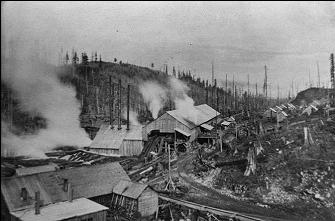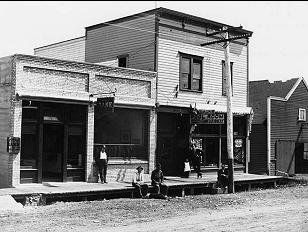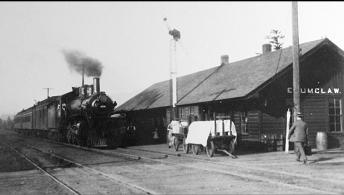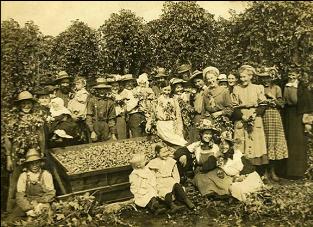Enumclaw Becomes a Town:
1879-1913
1879-1913
NOTES
1. Nancy Irene Hall. In the Shadow of the Mountain. The Courier Publishing, Enumclaw, 1983, and republished by Heritage Quest Press, Orting, 2004. p. 47.
2. Nancy Irene Hall. In the Shadow of the Mountain. The Courier Publishing, Enumclaw, 1983, and republished by Heritage Quest Press, Orting, 2004. p. 205.
3. Twelfth Census of the United States, 1900.
4. Poppleton, There Is Only One Enumclaw. 1995. p. 34.
5. Banks in Enumclaw "In days goneby, banking was local". Wally's World. Enumclaw Courier-Herald. July 16, 2012.
1. Nancy Irene Hall. In the Shadow of the Mountain. The Courier Publishing, Enumclaw, 1983, and republished by Heritage Quest Press, Orting, 2004. p. 47.
2. Nancy Irene Hall. In the Shadow of the Mountain. The Courier Publishing, Enumclaw, 1983, and republished by Heritage Quest Press, Orting, 2004. p. 205.
3. Twelfth Census of the United States, 1900.
4. Poppleton, There Is Only One Enumclaw. 1995. p. 34.
5. Banks in Enumclaw "In days goneby, banking was local". Wally's World. Enumclaw Courier-Herald. July 16, 2012.





While neighboring settlements were developing on the Plateau, Johannes Mahler delivered two people in his lumber wagon from Slaughter (Auburn) to a swampy place in the forest where the city of Enumclaw now sits. English immigrant Frank Stevenson had worked as a coal miner from Pennsylvania to Iowa, where he met and married Canadian-born Mary Fell. The couple moved on to California and then up to Washington in 1879, ten years before it became a state.
Frank built a one-room cabin behind what is now the city hall, and then set about clearing twenty acres of dense forest for farming. At the time, fir and other trees were often burned and cedar was split for boards and shakes. While Frank worked the land, Mary's chores included riding her horse on the trail to Osceola for the mail and to Wilkeson for supplies. (Wilkeson was linked by rail to Tacoma, but was larger than the port city at the time.) Mary crossed the White River at Boise Creek on James Johnson's ferry while her horse swam.
Frank and Mary Stevenson
1884 was a good year. Crops were successful and this enabled Frank to build a more substantial house. Two other Enumclaw pioneers, John Griffin and Arthur Blake, then came to town. On October 1, five years after the Stevenson's arrival, Frank filed a radial plat for Enumclaw with the King County Auditor, although John Blake convinced him to amend it. Concentric circles might have been appropriate for a medieval city like Paris, but they would have been impractical in a frontier town. (1)
Stevenson saw his future as developing a town rather than as farming, and began by giving Mary's father a free lot to build a saloon and Blake and Griffin one for a general store. Then he built a hotel, catering to railroad personnel and newcomers needing a place to stay while they looked for property. Later, the Stevensons also donated land for the school and the Presbyterian and Catholic churches.
Stevenson saw his future as developing a town rather than as farming, and began by giving Mary's father a free lot to build a saloon and Blake and Griffin one for a general store. Then he built a hotel, catering to railroad personnel and newcomers needing a place to stay while they looked for property. Later, the Stevensons also donated land for the school and the Presbyterian and Catholic churches.
The Northern Pacific Railroad was planning a route through the area to connect eastern Washington with Tacoma, and competition among the settlements was strong to have a siding on the line where goods could be loaded and unloaded. The Stevensons offered free land to the company, recognizing that a siding for freight promised a future that would more than pay for the property. Their offer was accepted and their prediction was correct. The siding and a trestle over the White River were built, and the link was completed to the Northern Pacific's western terminus in Tacoma. Now that the railroad connected Enumclaw with the rest of the country, both population and the business community expanded. By 1887, the population of Enumclaw had grown from 2 to 218. (2)
Railroad station in Enumclaw
Washington entered the Union as the 42nd state on November 11, 1889. In that same year, Elijah Goss founded the White River Lumber and Shingle Company in Enumclaw at the site of the future Weyerhaeuser mill. But in 1896, a fire destroyed the planing mill, and Goss sold out what was left to the Hansens, a Swedish immigrant family who already had other mills operating in the area. (more on logging)
White River Mill
Many of the farmers in the Enumclaw area discovered that growing hops brought in sudden cash and lots of it. Much of that money was spent in the growing town, encouraging more businesses to open. But the bubble burst with an infestation of hop lice and collapsing prices in the worldwide Panic of 1893. (A year later, the Improvement Company of Enumclaw closed its doors.) Though a few hop farmers weathered the crisis, many switched to dairy, an agricultural mainstay that has remained to this day.
Hop pickers
In the mid 1890s, Enumclaw boasted two stores, two hotels, two saloons, a drug store, a meat market, a feed store, a blacksmith shop, and a livery stable.
By the turn of the century, Enumclaw had a population of 483, according to the first U.S. census here. (3) In 1902, the Enumclaw Chamber of Commerce was founded, the same year that the Enumclaw Telephone System started, with seven subscribers. But soon area farmers joined the cooperative, paying $3 a year for the line and supplying their own poles. Anyone could listen in on others' calls, and often did, as this new technology linked isolated families around the Plateau. (4)
One outgrowth of agriculture in and around Enumclaw was the creation of cooperatives, for which the town soon became famous. Farmers' Mutual Insurance Company, the Cooperative Creamery, the Berry Cooperative, and Rochdale Store are four early examples. (more on cooperatives)
By the turn of the century, Enumclaw had a population of 483, according to the first U.S. census here. (3) In 1902, the Enumclaw Chamber of Commerce was founded, the same year that the Enumclaw Telephone System started, with seven subscribers. But soon area farmers joined the cooperative, paying $3 a year for the line and supplying their own poles. Anyone could listen in on others' calls, and often did, as this new technology linked isolated families around the Plateau. (4)
One outgrowth of agriculture in and around Enumclaw was the creation of cooperatives, for which the town soon became famous. Farmers' Mutual Insurance Company, the Cooperative Creamery, the Berry Cooperative, and Rochdale Store are four early examples. (more on cooperatives)
With the proliferation of other businesses in town, Enumclaw needed a bank and in the first decade of the 20th century, it got two, the State Bank of Enumclaw in 1904 and People's Bank six years later. (5) (more on banks)
In 1913, the townspeople voted on a proposal to incorporate as a city. Buckley had taken this step seventeen years earlier while Enumclaw had rejected it more than once. However, on January 27, the measure passed by a narrow margin, and thus we celebrated our centennial on that date in 2013.
In 1913, the townspeople voted on a proposal to incorporate as a city. Buckley had taken this step seventeen years earlier while Enumclaw had rejected it more than once. However, on January 27, the measure passed by a narrow margin, and thus we celebrated our centennial on that date in 2013.
State Bank of Enumclaw
The Kitchen is now located in this building.
The Kitchen is now located in this building.
Enumclaw's Certificate of Incorporation

